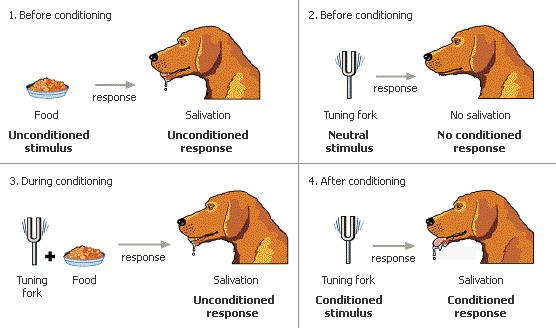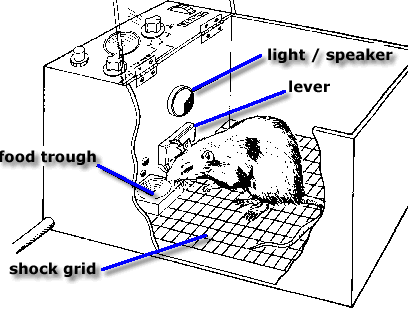- Learning – process by which experience produces a relatively enduring change in an organism’s behaviour or capabilities
Adapting to the Environment
- Behaviourists focus on how organisms learn, examining the processes by which the experience influences behaviour
- Ethology focuses on the functions of behaviour
- Adaptive significance – how behaviour influences an organism’s chances for survival
- Fixed action pattern – unlearned response automatically triggered by a particular stimulus
- Environment shapes behaviour in two fundamental ways:
- Personal adaptation (behaviorists) – behaviour is influenced by immediate environment and by capabilities that have been acquired through experience
- Species adaptation (ethology) – genetically based features that enhance a species’ ability to adapt to the environment are more likely to be passed on to future generations
- Habituation – decrease in strength of response to repeated stimulus
- Occurs across nearly all species
- Allows organisms to conserve energy by not responding to every stimulus in environment
- Occurs within central nervous system, not within sensory neurons (like sensory adaptation)
Classical Conditioning
- Classical conditioning – learning to associate two stimuli such that one stimulus comes to produce a response that originally was only produced by the other stimulus
- Pavlov discovered that when a stimulus is associated with food, dogs will learn to associate the stimulus with food, and will salivate
- Before conditioning:
- Tone > No salivation
- Food (UCS) > Salivation (UCR)
- During conditioning:
- Tone (CS) + Food (UCS) > Salivation (UCR)
- After conditioning:
- Tone (CS) > Salivation (CR)
- Before conditioning:
Basic principles of classical conditioning
- Acquisition
- Period during which a response is being learned
- CS is paired with UCS to establish a strong CR
- Fastest: forward trace pairing (CS appears before UCS)
- Slower: simultaneous pairing (CS appears with UCS)
- Slowest: backward pairing (CS appears after UCS)
- Generally strongest when repeated pairings, intense UCS, and sequence involves forward pairing with a short break between CS and UCS
- Extinction and Spontaneous Recovery
- Extinction – if CS is presented repeatedly without UCS, CR will weaken and disappear
- Repeated extinction trials will speed up extinction
- Spontaneous discovery – reappearance of a previously extinguished CR after a rest period, without new learning trials
- CR from spontaneous recovery is usually weaker
- Extinction occurs more rapidly
- Extinction – if CS is presented repeatedly without UCS, CR will weaken and disappear
- Generalization and Discrimination
- Stimulus generalization – once CR is acquired, organism will respond to other stimuli that are similar to original CS
- Greater chance for CR in more similar CS
- Discrimination – when a CR occurs to one stimulus, but not to others
- Stimulus generalization – once CR is acquired, organism will respond to other stimuli that are similar to original CS
- Higher-Order Conditioning
- Higher-order conditioning – a neutral stimulus becomes a CS after paired with another CS (rather than the original UCS)
- Typically, the new CS is weaker and extinguishes sooner
- Higher-order conditioning – a neutral stimulus becomes a CS after paired with another CS (rather than the original UCS)
Applications of classical conditioning
- Acquiring and Overcoming Fear
- Most fears are conditioned
- Exposure therapy – technique designed to extinguish anxiety responses by exposing clients to anxiety-arousing stimuli or situations, allowing extinction to occur
- Systematic desensitization – patient learns relaxation techniques and then is gradually exposed to the fear-provoking stimulus
- Flooding – immediately exposes the person to the phobic stimulus
- Conditioned Attraction and Aversion:
- Aversion therapy – attempts to condition an aversion to a stimulus that triggers unwanted behaviour by pairing it with a harmful UCS
Operant Conditioning
- Operant conditioning – type of learning in which behaviour is influenced by its consequences
- Law of Effect (Thorndike) – in a given situation, a response followed by an unsatisfying outcome will become less likely to occur
- B. F. Skinner viewed operant conditioning as form of natural selection that facilitates personal adaptation
- Skinner box – box with lever that, if pulled, drops food into cup
- Skinner found that rat will press bar more frequently over time
- Several important types of consequences:
- Reinforcement – response is strengthened by an outcome that follows it
- Caused by reinforcer (such as food)
- Punishment – response is weakened by an outcome that follows it
- Caused by punisher (electric shock)
- Reinforcement – response is strengthened by an outcome that follows it
- Skinner’s analysis of operant behaviour involves three events
- Antecedents – stimuli prevented before behaviour occurs
- Behaviours – behaviour that the organism emits
- Consequences – what follows the behaviour
- Discriminative stimulus – signal that a particular response will produce certain consequences (e.g. a light that would signal the rat to pull the lever, but if no light was on, no food would come out)
Consequences
- Positive reinforcement – a response is strengthened by the presentation of a stimulus (positive reinforcer)
- Primary reinforcer – stimuli that an organism finds reinforcing due to biological needs (e.g. water or food)
- Secondary/Conditioned reinforcer – stimuli that acquires reinforcing qualities by being associated with a primary reinforcer (e.g. money)
- Negative reinforcement – a response is strengthened by the removal or avoidance of a stimulus (negative reinforcer)
- Operant extinction – the weakening and eventual disappearance of a response because it is no longer reinforced
- Resistance to extinction notes the degree to which non-reinforced responses persist
- Positive punishment – a response is weakened by the presentation of a stimulus
- Often produces rapid results
- Suppression may not generalize to relevant situations
- Negative punishment – a response is weakened by the removal of a stimulus
- Reinforcement or punishment that occurs immediately after behaviour has a stronger effect than when delayed
- Delay of gratification – the ability to forego an immediate but smaller reward for a delayed by more satisfying outcome
Shaping and Chaining
- Shaping – reinforcing successive approximations toward a final response
- Example: To get a child to be active when he usually sits and does nothing, first reward him every time he gets up, then only when he walks towards something active, then only once he does something active
- Chaining – reinforcing each response with the opportunity to perform the next response
- Example” At first the rat learns to press a lever when it sees a light, but after accidentally hitting a bell nearby that turns the light on, the rat will learn to ring the bell
Generalization and Discrimination
- Operant generalization – an operant response occurs to a new stimulus or situation that is similar to the original
- Operant discrimination – an operant response will occur to one stimulus, but not another
Schedules of Reinforcement
- Continuous reinforcement – every response of a particular type is reinforced
- Partial reinforcement – only some responses are reinforced
- Ratio schedules are based on a certain percentage of reinforced responses
- Fixed ratio schedule – reinforcement is given after a fixed number of responses (e.g. food after three pulls of lever)
- Variable ratio schedule – reinforcement is given after a variable number of correct responses, all centered around an average (e.g. slot machine pays on average every 20 pulls)
- Interval schedules are based on a certain amount of time elapsing between reinforcements
- Fixed interval schedule – first correct response that occurs after a fixed time interval is reinforced (e.g. food only on first pull of lever every 20 minutes)
- Variable interval schedule – reinforcement is given for the first response that occurs after a variable time interval (e.g. quizzes about every 2 weeks)
- Ratio schedules are based on a certain percentage of reinforced responses
- Partial reinforcement is learned slower, but more resistant to extinction (especially on variable schedule)
- Takes longer to realize that variably reinforced responses are not occurring
Escape and Avoidance Conditioning
- Escape conditioning – a form of learning in which the organism learns to perform a behaviour in order to escape from an aversive stimulus (e.g. rat will run to other room if floor causes shock)
- Maintained through negative reinforcement
- Avoidance conditioning – a form of learning in which the organism learns a response to avoid an aversive stimulus (e.g. rat will run to other room if light warns of shock to come)
- Two factor theory of avoidance learning – classical and operant conditioning are involved
- Classical: warning light is a neutral stimulus associated with shock (UCS), which turns light into CS causing fear (CR)
- Operant: fleeing from the light is negatively reinforced by the termination of fear, strengthening the avoidance response
- Avoidance response prevents extinction from occurring, since rat will never stay long enough to know if shock still occurs
- Two factor theory of avoidance learning – classical and operant conditioning are involved
Applications of Operant Conditioning
- Animals can be trained to do various tasks (assist disabled, perform, etc.)
- Applied behaviour analysis – program designed and implemented to change behaviour, and effectiveness is measured before and after
Biology and Learning
- Preparedness – through evolution, animals are biologically prewired to easily learn behaviours related to survival
- Conditioned taste aversion – learned repulsion to food by virtue of pairing it with an aversive UCS (e.g. nausea, illness, etc.)
- Humans have tendency to develop certain phobias more easily (e.g. spiders, snakes, dangerous places)
- Instinctive drift – a conditioned response that drifts back towards instinctive behaviour
Cognition and Learning
- Edward Tolman found that if rats were presented a route in a maze that led to a box, and then that route was blocked, but multiple other ones were opened, the rats would choose the path that headed in the direction of the box
- Not explained by reinforcement theory
- Cognitive map – mental representation of the spatial layout of an area
- Learning does not merely stamp in stimulus-response connections, but provides knowledge, from which organisms develop an expectancy (a cognitive representation of “what leads to what”)
- Classical conditioning forms a CS-UCS link (expectancy model)
- Most important factor in classical conditioning is how well the CS predicts (i.e. signals) the appearance of a UCS
- Not how often the CS and UCS are paired
- Explains why organisms aren’t conditioned to all neutral stimuli that are present prior to a UCS (since they do not consistently predict a UCS)
- Also explains why forward pairing is most effective
- Most important factor in classical conditioning is how well the CS predicts (i.e. signals) the appearance of a UCS
- Organisms develop an awareness or expectancy of relations between their responses and probable consequences
- Best predictor of behaviour is the perceived contingency, not the actual one
- Often are identical, but sometimes not (e.g. superstitions)
- Best predictor of behaviour is the perceived contingency, not the actual one
- Latent learning – learning that occurs but is not demonstrated until there is an incentive to perform
- Observational learning – learning that occurs by observing the behaviour of a model



At your approval, I request to use your graphic organizer of the Pavlovian dog experiment in a research paper I am writing for a doctoral class on tracking in education and how it has been formed by the functionalist paradigm… Pavlov is a Behaviorist that falls under the functionalism paradigm and therefor provides examples of shared thoughts and theories by functionalists.
Thank you!